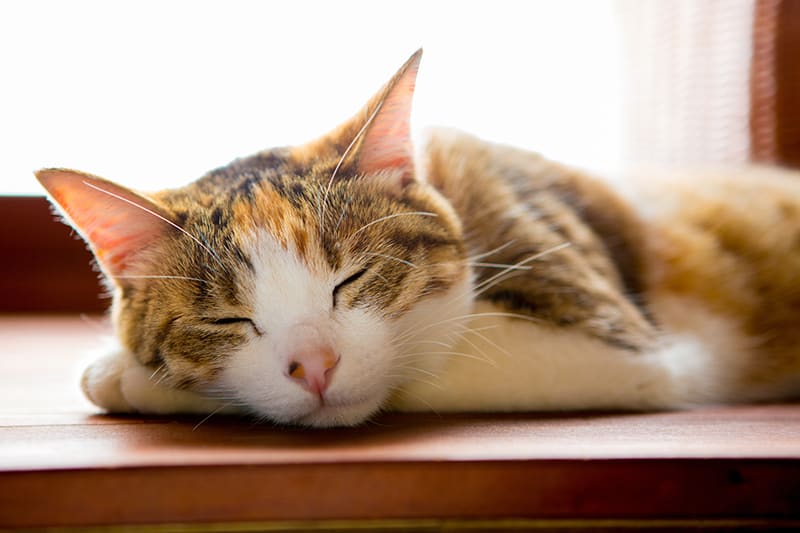Red Blood Cells & Your Cat's Health
Red blood cells (otherwise known as erythrocytes) carry oxygen to a cat’s tissues. Hemoglobin are molecules that carry the oxygen within red blood to cells, which then use the energy the body needs to perform normal day to day activities.
Throughout this process, carbon dioxide is left behind as a waste product. Your cat's red blood cells carry the carbon dioxide away from the tissues back to the lungs, where your cat exhales it.
Causes of Low Red Blood Cells in Cats
Your cat’s metabolism naturally protects both red blood cells and hemoglobin from damage. A reduction in the number of red blood cells can occur if there is:
- Interruption in production or survival of red blood cells
- Poor metabolism
- Interference in the formation or release of hemoglobin
Red blood cells are produced in the bone marrow. In healthy animals, the total number of red cells remains constant over time. Mature red blood cells have a limited life span, which means their creation and death must be carefully timed, or disease can develop.
These cells circulate for about two months and as they age or become damaged, they are removed from the bloodstream.
If your cat loses too many red blood cells or production decreases significantly, this can result in a lack of red blood cells, which in turn leads to anemia. There are two types of anemia that we can see in cats: regenerative anemia and non-regenerative anemia.
Regenerative Anemia
Regenerative anemia occurs when your cat's body is producing red blood cells as it should but is unable to meet demand. This form of anemia can be caused by:
- Blood loss (internal or external) from injury, parasites, tumors, accident, ulcers
- Hemolysis (when the body destroys red blood cells because they appear abnormal)
- Toxins (from accidentally ingesting food, medications, heavy metals)
- Infections
Non-regenerative Anemia
Non-regenerative anemia happens when kitty's body is not making a normal amount of red blood cells. Non-regenerative anemia in cats can be caused by:
- Bone marrow disorders
- Poor diet
- Kidney disease
- Chronic diseases
Signs of Anemia in Cats
Anemia is a symptom of an underlying condition or disease, but is not a specific disease in itself. If your cat is anemic you may notice one or more of the following symptoms:
- Weakness
- Lethargy
- Pale pink or white gums
- Decreased appetite
- Increased breathing rate
- Increased heart rate
- Drinking more water
- Collapse
In severe cases, respiratory effort will also increase as your cat attempts to inhale more oxygen into the lungs to improve the level of oxygen in their body. Left untreated anemia can be debilitating for your cat, and may even become life-threatening.
Diagnosis and Treatment of Anemia in Cats
Your vet will need to collect a Complete Blood Count (CBC) from your cat so it can be tested to tell him or her how many red blood cells, hemoglobin, white blood cells and platelets your pet has. This can also reveal the type of anemia.
Once the type of anemia is known, your vet can recommend other tests depending on your cat’s symptoms to identify the cause of the anemia. Treatment will depend on the severity of the condition, as well as the underlying cause. In some cases, this may include a change in diet or medication, surgery, blood transfusion or other treatments.
How to Increase Red Blood Cells in Cats & Prevent Anemia
Anemia in cats can have a number of causes, which means that whenever possible prevention is important. Ensure your cat is getting all the nutrients he needs in his diet, and reduce the risk of blood loss by scheduling routine wellness exams to have him checked for parasites and other health issues.
Also, keep your kitty up to date on their vaccines and parasite prevention. When it comes to treatment with blood transfusions, multiple transfusions may be needed before the cat’s body can create enough red blood cells on its own. If you need to boost your cat’s red blood cells, iron-rich foods may help.
What are good sources of iron for cats?
If your cat is found to be iron deficient, your vet may recommend adding iron-rich foods to your kitty's diet, or giving an iron supplement.
Iron-rich foods include lean meat such as turkey, pork, beef and chicken (just make sure to trim the fat off pork products before feeding to your cat, as too much can cause pancreatitis). Fish also makes the list, as do eggs (with the caveat that eggs are an occasional treat and must be cooked well to reduce risk of food poisoning).
Always get your vet’s okay before adding any new food to your cat’s diet, in case more serious medical treatment is required or your cat has a food allergy.
If you notice signs of anemia in your cat, make an appointment with your vet right away. They can perform tests and develop a custom treatment plan, which may include actions you can take at home to help him recover.
Note: The advice provided in this post is intended for informational purposes and does not constitute medical advice regarding pets. For an accurate diagnosis of your pet's condition, please make an appointment with your vet.
Is your cat showing signs of anemia? Book an appointment today for your feline friend. Our Greensboro vets have experience diagnosing and treating a range of diseases in cats, including anemia.
Looking for a vet in Greensboro?
We're always accepting new patients, so contact our veterinary hospital today to book your pet's first appointment.
Related Articles View All
What happens during a routine pet exam?
Routine wellness exams are a proactive way to help safeguard your pet's long-term health and vitality. Why should you take your healthy pet to the vet? What happens during a pet health wellness exam? Find out.
How much does an emergency vet visit cost?
Emergency veterinary care can be costly, but planning ahead allows you to make decisions about your pet's care based on their needs rather than financial restrictions. Today, we look at the cost of emergency vet care, and how to be ready if your pet needs emergency treatment.
Does my cat have asthma?
The treatment for asthma in cats can seem daunting for many pet parents. But your veterinarian can lead you through the diagnosis and treatment process, to help get your cat breathing easier.


